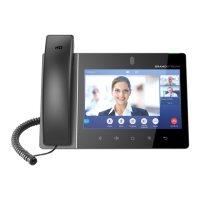● Session Level:use AS format in session level.
● None:no modifications in the session format.
Note:
Please do not modify this setting without knowing the session format supported by the
server. Otherwise, it might cause video decoding failure.
H.264 Payload Type
Specifies the H.264 codec message payload type format. The default setting is 99.
The valid range is from 96 to 126.
Presentation Settings
Enable BFCP
If set to “Yes”, the device will be able to receive the presentation stream in video calls and video
meetings.
Initial INVITE with Media
Info
Initial INVITE SDP contains presentation media.
Presentation H.264
Image Size
Selects the H.264 image size. Users can select 1080P or 720P.
Presentation H.264
Profile Type
Select the Presentation H.264 Profile Type from “Baseline Profile”, “Main Profile”, “High Profile”
and “BP&MP&HP”. The default setting is “BP&MP&HP”.
The lower the profile type is, the easier the packet can be decoded. However, higher level has
high compression ratio. For device with low CPU, select “Baseline Profile” to play record;
“Baseline Profile” is more likely to be used in a video conference that has high demanding for the
video quality. Select among the three types to achieve best video effect.
Presentation Video Bit
Rate
Configures the bit rate of the video. The video bit rate can be adjusted based on the network
environment. Increasing the video bit rate may improve video quality if the bandwidth is
permitted. If the bandwidth is not permitted, the video quality will decrease due to packet loss.
Video Bit Rate can be set to integer value from 512kbps to 2048kbps.
Presentation Video
Frame Rate
Configure the video frame rate for presentation.
BFCP Transport Protocol
Defines the transport protocol used for BFCP. Users can choose from Auto/UDP/TCP. The default
setting is “UDP” first, if not supported, then choose “TCP”. If choose “Auto”, automatically
switches between “UDP” and “TCP”.
RTP Settings
SRTP Mode
Sets if the phone system will enable the SRTP (Secured RTP) mode. It can be selected from
dropdown list:
● Disable
● Enabled but not forced
● Enabled and forced
SRTP uses encryption and authentication to minimize the risk of denial of service. (DoS). If the
server allows to use both RTP and SRTP, it should be configured as “Enabled but not forced”. The
default setting is “Disable”.
SRTP Key Length
Configures all the AES (Advanced Encryption Standard) key size within SRTP. It can be selected
from dropdown list:
● AES128 & 256 bit
● AES 128 bit
● AES 256 bit
If it is set to “AES 128 & 256 bit”, the phone system will provide both AES 128 and 256 cipher
suite for SRTP. If set to “AES 128 bit”, it only provides 128-bit cipher suite; if set to “AES 256 bit”,
it only provides 256-bit cipher suite. The default setting is “AES128&256 bit”.

